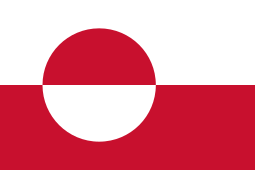 | |
| Other names | Erfalasorput ("our flag"), Aappalaartoq ("the red") |
|---|---|
| Use | National flag and civil ensign |
| Proportion | 2:3 |
| Adopted | 21 June 1985[1] |
| Design | A horizontal bicolour of white and red, with a counterchanged disk slightly off-centre towards the hoist. |
| Designed by | Thue Christiansen |


The flag of Greenland (Greenlandic: Kalaallit erfalasuat, Danish: Grønlands flag) was designed by Greenland native Thue Christiansen.[2] It features two equal horizontal bands of white (top) and red (bottom) with a counter-changed red-and-white disk slightly to the hoist side of centre. The entire flag measures 18 by 12 parts; each stripe measures 6 parts; the disk is 8 parts in diameter, horizontally offset by 7 parts from the hoist to the centre of the circle, and vertically centered.
Its local name in the Greenlandic language is Erfalasorput, which means "our flag". The term Aappalaartoq (meaning "the red") is also used for both the Greenlandic flag and the flag of Denmark (Dannebrog). Today, Greenlanders display both the Erfalasorput and the Dannebrog[3]—often side by side. The flag of Greenland is the only national flag of a Nordic country or territory without a Nordic cross, but is similar to the cultural Sámi flag, which also features a circular design and counterchanging of field and charge.
- ^ "Politics in Greenland – Government of Greenland". Archived from the original on 2017-10-15. Retrieved 2014-09-01.
- ^ "Greenland's flag". Nordic Council. Archived from the original on 15 March 2012. Retrieved 8 May 2012.
- ^ "The Greenland flag in the capital Nuk, Greenland". GRID-Arendal. Archived from the original on 2018-12-14. Retrieved 2018-12-11.